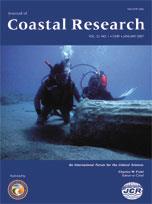Land subsidence due to consolidation of sediment was analyzed in the Yellow River delta, using lithological data of deposits, equations of soil mechanics, and empirical relations. Subsidence in an abandoned deltaic lobe largely results from the consolidation of deltaic clay layers accumulated in the prodelta, the bays, and marine clay layers underlying the delta. The prodelta and marine clay layers have a total thickness of approximately 14 m. In the areas where thick bay-clay layers accumulated on the prodelta-clay layers, the total thickness of the clay can reach 20 m. Calculations show that after 15-m-thick deltaic strata were deposited on the seabed, the total consolidation of the 14-m-thick clay layers is approximately 1.44 m and 1.52 m for the 20-m-thick clay layers. After the first 40 years, the rate of land subsidence resulting from consolidation of the 14-m-thick clay layers will decrease gradually to 0.005 m/y. For the 20-m-thick clay layers, it will take 57 years for the rate of subsidence to decrease to 0.005 m/y.
How to translate text using browser tools
1 January 2007
Land Subsidence as a Result of Sediment Consolidation in the Yellow River Delta
Shi Changxing,
Zhang Dian,
You Lianyuan,
Li Bingyuan,
Zhang Zulu,
Zhang Ouyang
ACCESS THE FULL ARTICLE

Journal of Coastal Research
Vol. 2007 • No. 231
January 2007
Vol. 2007 • No. 231
January 2007
Deltaic deposits
marine deposits
sediment compression




